Installing a hot tub or spa at home can be wonderful. Below, we explore the benefits of hydrotherapy. Whether you plan to DIY or hire help, this guide covers everything you need to know to get your tub up and running in your garden.
Hot tubs are typically large and installed outdoors where there’s ample space. This project focuses on installing a garden hot tub either outdoors or within a garden structure like a cabin or gazebo.
Understanding Hot Tubs, Spas, and Jacuzzis
Let’s clarify the difference between a hot tub, spa, and Jacuzzi. In reality, there’s no strict distinction, so these terms are often used interchangeably in installation guidelines.
A hot tub typically refers to a non-jetted tub, often wooden.
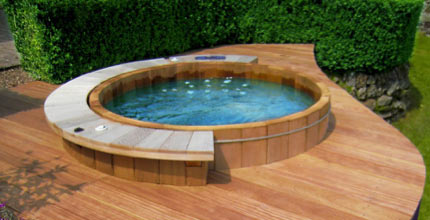
Designer hot tub by Adriano Pianesi
A spa usually features jets that mix air and water for a massaging effect, commonly made from moulded plastic. The terms Jacuzzi and Whirlpool are brand names often used to describe spas.
Next, we explore the hydrotherapy benefits available from a garden spa.
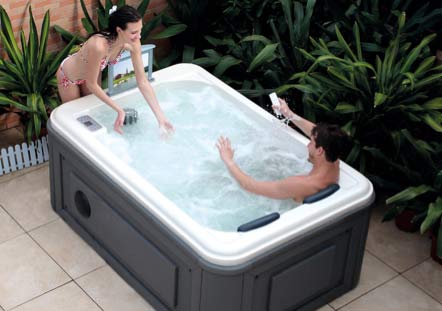
A typical garden spa
Planning Your Hot Tub Installation
Before starting, ensure you don’t need planning permission. While most cases won’t require it, if you’re in a listed building, conservation area, or Area of Outstanding Natural Beauty, you likely will.
Contact your local planning authority via the Planning Portal to confirm.
Even if your hot tub or garden spa doesn’t need permission, structures like cabins and gazebos might. Many can qualify as permitted developments within certain dimensions.
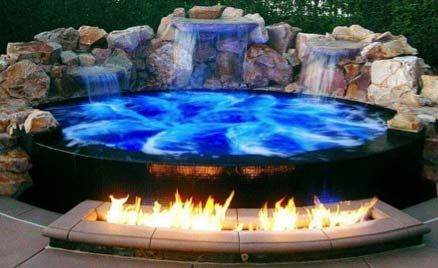
Hot tub as a garden feature
Regarding building regulations, you’ll likely not need building control unless your structure exceeds 30 sq m in floor space, regardless of walls.
Ensure access to hot and cold water, waste disposal, and electricity comply with regulations.
An electrician must sign off on wiring, as safety is paramount and not a DIY task.
Choosing the Right Location for Your Hot Tub or Spa
Once you’re aware of any restrictions, you can proceed to select an ideal spot for your spa or hot tub. Here are key considerations, though your specific situation may add more:
Practical Considerations for Your Hot Tub
Getting water, electricity, and ensuring proper waste water removal are essential for your spa or hot tub. Placing it far from your home will complicate installation and increase costs. Ideally, position it relatively close to the house.
Level ground is crucial for the hot tub’s base. We’ll discuss how to prepare this foundation in detail later. Avoid placing the tub on a steep slope, even if the view is spectacular, as it can cause installation difficulties.
Accessibility to Your Hot Tub
Convenience is key when using your hot tub. Opt for a location near your house for easy access—this ensures you can quickly retrieve forgotten items without a trek. You may also need to build a path leading to it for seamless accessibility.
If you have a pool, placing your hot tub nearby allows you to enjoy both amenities and utilise shared utilities.
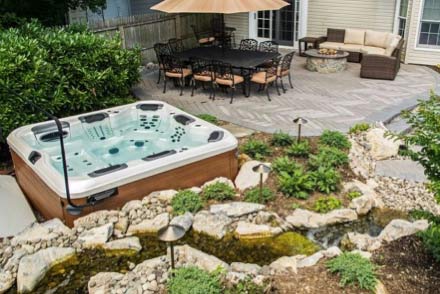
Positioning your Spa in the right place can make even more attractive
Weather Considerations for Your Spa
Your enjoyment of your spa is heavily influenced by the weather. Look for a sheltered spot away from wind, ideally with sunlight during your preferred time of day—typically a south-facing location is optimal.
Building a canopy or trimming overhanging branches is simpler than relocating your hot tub after installation. If needed, you can easily construct a fence to provide additional shelter.
Privacy and Neighbour Considerations
When choosing a location for your spa or hot tub, consider your neighbours. Opt for a spot where conversations and activities won’t disturb them, ensuring your privacy and theirs.
Enhance privacy by constructing a canopy or strategically planting foliage around the area.
Hot Tub Safety
When choosing a location for your hot tub, safety is paramount, especially if children are present or expected in your garden. Ensure it’s positioned to prevent unsupervised access.
Consider accessibility by installing sturdy handrails and a secure platform for safe entry and exit.
Building the Base for Your Hot Tub or Garden Spa
Once you’ve chosen the perfect spot for your hot tub or spa, the next step is preparing the base. Even if the supplier will install it, they expect the location to be ready upon delivery.
There are two critical considerations when building the base: it must be able to support the heavy weight (at least 1.5 tonnes) and it must be perfectly level. Consult your tub’s specifications or salesperson for exact weight requirements.
The base should also accommodate the hot tub, heat pump, and necessary utilities, with enough space for easy access without stepping directly from the lawn.
You can opt to sink the tub into the ground, but this requires digging and running utilities. Typically, the tub sits on a ground-level base.
Similar to building a shed base, focus on creating a secure, flat surface. There are various acceptable methods to achieve this:
Concrete Base
A concrete base is the most solid and durable option. If the ground beneath the tub is uneven, adding sand over the concrete can help better support the tub.
To build your base, follow the shed base instructions. The concrete thickness should be between 4 to 6 inches, depending on the hot tub’s size and weight.
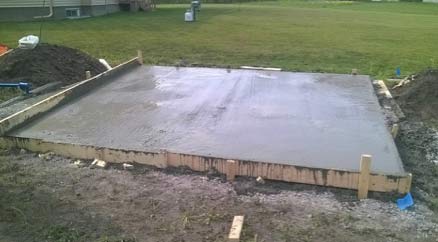
A concrete hot tub base – Image courtesy of the HotTubGuys
Paving Slabs
Creating a base with paving slabs is similar to making a patio where you can position your hot tub. Learn more about laying a paving slab base in our building a patio project.
Decking
Using decking as a base is challenging due to the weight and forces it needs to support. Ensure you verify the requirements with your supplier. If unsure about reinforcing your decking, consider professional assistance.
If decking is your preferred option, learn how to build one in how to build decking project here.
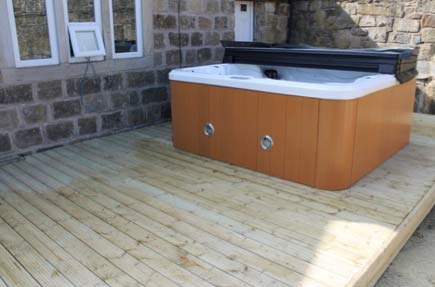
A hot tub positioned on decking
Spa Pads
You can buy interlocking pads for a quick and simple base solution. While not as secure as a permanent option, they are perfect for portable spas.
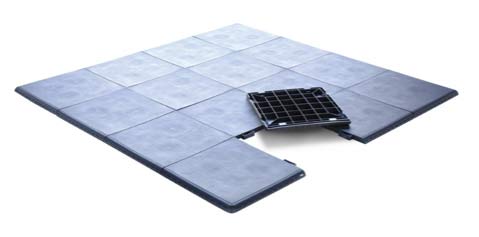
Select the recommended pads for your spa or hot tub
Gravel Base
You can place your spa on a gravel base, which helps absorb splashes. The weight of the tub will keep it stable, but this isn’t as permanent as a solid concrete base.
To build this, follow the same process as you would for laying a gravel driveway or pathway.
While you’re at it, consider building any necessary access areas and pathways to the spa. It’s easier to do this before placing the tub.
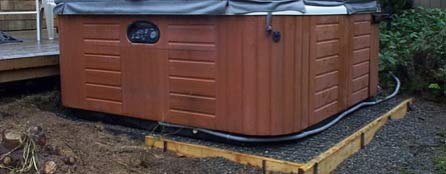
A hot tub on a gravel base – Image courtesy of Purus North America
Installing a Hot Tub or Spa
Installing a hot tub or spa can be challenging due to its weight and size. It’s crucial to plan how you’ll move it to your desired spot in the garden.
Some suppliers offer trolleys for easier transport, but you’ll need a clear path without obstacles. You might even need to temporarily remove a fence panel to manoeuvre it into place.
In extreme cases, hiring a crane might be necessary for placement.
Discuss these logistics with your supplier to avoid unexpected delays or difficulties in delivery.
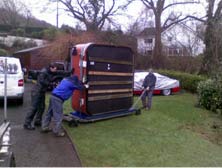
Getting a hot tub into position – Image courtesy of Oyster Pools and Leisure)
The Electrical Requirements for Hot Tubs and Spas
Alongside planning and building regulations, the electrical setup for your hot tub is critical. Compliance with Part P of the building regulations is essential.
As a homeowner, it’s your responsibility to ensure an electrician certifies the installation as safe, providing you with a necessary certificate upon completion.
There are two main types of electrical setups for hot tubs and spas, and your supplier will liaise with your electrician to determine the specific requirements.
13 Amp ‘Plug and Play’ Tubs:
For smaller hot tubs and spas, a 13 amp supply is sufficient. These can be directly plugged into a standard 3-pin outdoor socket, provided it’s protected by an RCD (Residual Current Device).
Dedicated Supply Tubs
For hot tubs and spas that require a supply greater than 13 amps, they will need their own dedicated supply meeting the following requirements:
- The supply should be on its own fused spur, separate from other appliances.
- An RCD (Residual Current Device) should protect the hot tub to trip the power in case cables are damaged or waterlogged.
- The supply should have its own MCB (Mains Circuit Breaker) covering the maximum draw of the tub plus 25% to handle surge during pump startup.
- All cabling should be Steel Wired Armoured (SWA) or laid in protective ducting when installed outdoors.
- An isolation switch should be installed at least 2m away from the tub to cut power in emergencies or for maintenance.
Before the electrician completes the job, ensure the tub is filled and tested to confirm everything works correctly and the installation meets your satisfaction.
Many hot tubs include a ‘commissioning’ process to ensure proper installation and familiarise you with the basic functionality of your new tub.
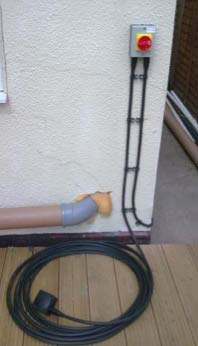
The isolation switch for a dedicated supply hot tub
Ongoing Maintenance for Hot Tubs and Spas
Maintaining your spa or hot tub is essential once it’s installed. The level of maintenance required varies by model, so always refer to the manufacturer’s guidelines.
Typical maintenance tasks include:
- Checking pH levels, potentially daily if used frequently
- Cleaning the tub, especially at the waterline
- Cleaning or replacing the filter cartridge
- Performing a complete water change by draining and refilling
Regular cleaning and maintenance are crucial aspects we want to emphasise. Specific tasks beyond these basics will depend significantly on your model.
Benefits of Hydrotherapy
Everyday stresses can lead to muscle tension, restricted blood flow, fatigue, and headaches. Spaform collaborates with medical researchers to explore the benefits of regular spa use.
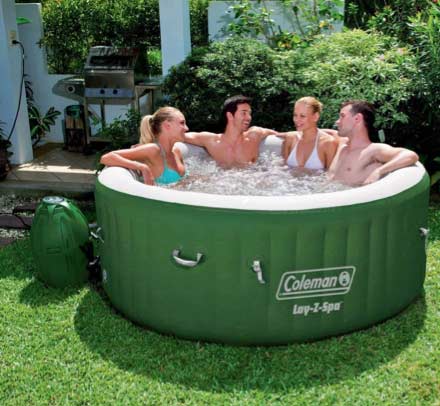
Portable Inflatable hot tub
Soaking in hot water dilates blood vessels, enhancing circulation and cardiac output without extra stress on the heart. Increased bodily fluid helps remove toxins around injuries and excess joint fluid, offering relief to rheumatism and arthritis sufferers.
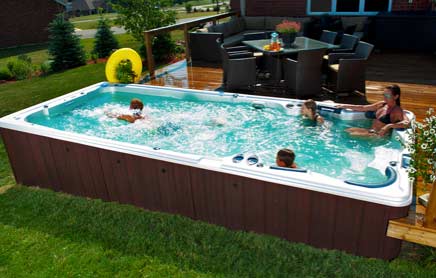
Swim Spas and Pools – Image courtesy of Hydropools UK
Buoyancy in water reduces body weight by 90%, easing pressure on joints and muscles. This relaxation, combined with improved circulation and joint mobility, enhances overall well-being.
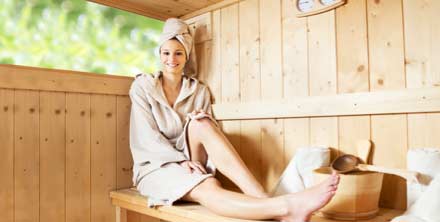
Saunas and Steam Rooms – Image courtesy of Curejoy
Hydro-massage, delivered through air and water jets, alleviates muscle tension and promotes the body’s natural healing processes through therapeutic massage.
In addition to the physical benefits of using a spa, the increased fluid intake helps dilute “stress hormones” in the blood, such as adrenaline, promoting relaxation and reducing daily stress.

